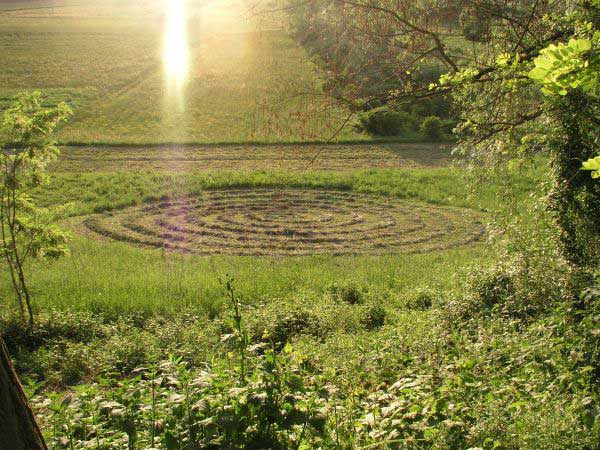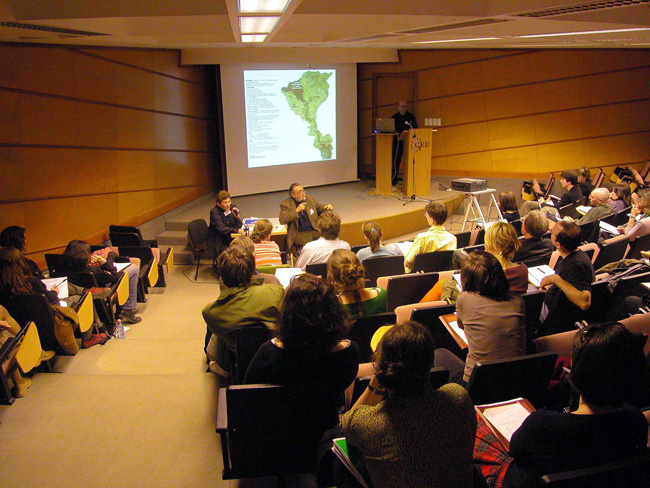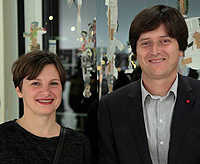Politics, the Environment and Art Across a Changing Political Landscape: Interview with Maja and Reuben Fowkes
Maja and Reuben Fowkes’s essay, “Green Critique in a Red Environment: East European Art and Ecology under Socialism” can be found in ARTMargins print journal (#3.2. 2014) as part of this online/offline project. In the following interview, they reflect upon contemporary artists that are addressing environmental and sustainability concerns, as well as larger issues connected to these themes.

Janeil Engelstad: Taking a broad look at Central European artists working today in ecology and with sustainability, do you sense that there is a collective art/environmental scene? And if so, do you see this work as strengthening the larger Environmental Movement?
Maja and Reuben Fowkes: It is certainly possible to identify various trends and flows within contemporary Central European art that are connected to the spread of ecological thinking, although, in our opinion, without coalescing into a movement. Environmental activism is one pole around which artists have come together, but again this tends to be related to specific issues or campaigns. In that sense, it was interesting that when in 2013 mass environmental protests sprung up in Romania over plans to develop destructive open-pit gold mining in Transylvania, on the whole artists took part more as citizens than by addressing the issue through their art practice. Nevertheless, Romanian artist Dan Perjovschi participated by disseminating his drawings as readymade ideas for protest banners, which could be downloaded from social media.(For an interview with Dan Perjovschi see https://www.artmargins.com/index.php/5-interviews/728-interview-with-dan-perjovschi.)
Where, perhaps, it is possible to see signs of an environmental movement is on the elevated level of planetary politics, when Central European artists, through personal inclinations, meaningfully contribute to the transition towards an ecological age. One such artist was Ivan Ladislav Galeta (1947-2014), who sadly passed away earlier this year. Galeta lived and worked in the countryside near Zagreb, where he combined new media with permaculture and ecology with animal ethics. At the Art and Sustainability Symposium in Budapest in 2008, he proposed that February 28 be adopted as “NoArt Earth Day,” with the idea that we should refrain for a day from adding to the stockpile of artworks for the wellbeing of the planet. As curators and art historians, we are most interested in artists who not only deal with environmental themes as subject matter for their work, but also find ways to integrate environmental positions into their lifestyles, which, in turn, influences their practice. Galeta was such an artist.
JE: There is a widening effort by artists to use their knowledge and skills to address environmental problems. To that end, they are often collaborating with NGOs and professionals from other disciplines, such as scientists. Do you see these kinds of purposeful collaborations also expanding in Central Europe?
 MRF: It may well be that the familiar institutionalized form of art and science collaborations are not a global phenomenon, but rather arise in particular economic and cultural circumstances, so that to expect to find similar examples in Central European art may imply a normative leveling of art practice according to Western principles and experience, where artist residencies at natural history museums or scientific research centers, for example, regularly take place as partof well-funded strategic programs. These programs often entail a certain level of compromise by not asking difficult questions, which ecology understood as a critique necessarily implies. In Central Europe, there is currently no equivalent infrastructure of artist residencies and open calls to collaborate with scientists, and, in general, the funding for arts, as well as science, is much less generous. Where we do encounter such successful collaborations, they tend to be based on personal initiatives.
MRF: It may well be that the familiar institutionalized form of art and science collaborations are not a global phenomenon, but rather arise in particular economic and cultural circumstances, so that to expect to find similar examples in Central European art may imply a normative leveling of art practice according to Western principles and experience, where artist residencies at natural history museums or scientific research centers, for example, regularly take place as partof well-funded strategic programs. These programs often entail a certain level of compromise by not asking difficult questions, which ecology understood as a critique necessarily implies. In Central Europe, there is currently no equivalent infrastructure of artist residencies and open calls to collaborate with scientists, and, in general, the funding for arts, as well as science, is much less generous. Where we do encounter such successful collaborations, they tend to be based on personal initiatives.
The symposium on sustainability and contemporary art that we have organized regularly since 2006 with the Department of Environmental Science and Policy at Central European University, Budapest, could be seen as an example of such collaboration at a curatorial level, bringing together artists, theorists, environmentalists and activists to find disciplinary crossing points and common ground for addressing specific aspects of the collective response to ecological crisis.(For more information on the Symposium on Sustainability and Contemporary Art see the Translocal Institute for Contemporary Art website: http://www.translocal.org/activities.html.) The inclusion of artists from Central and Eastern Europe has also always been an important consideration, along with experiments with formats to improve and deepen collaborations, such as by moving the discussion outside the institutionalized frame of the university, or even the city.
JE: In their projects for this issue of ARTMargins Online, Oto Hudec and Tamás Kaszás both reflect on how “the crisis” of the past few years has influenced, and even encouraged, them to make work that addresses the issue of sustainability. Do you see other artists throughout the region turning to sustainability as a theme in response to the economic crisis?
MRF: The influence of the economic crisis on artistic practices in the region is definitely a factor, although we would argue that generally it has had quite a negative effect in drawing attention away from underlying environmental questions. It is also important to take into account that the financial crisis has not affected all the countries of Eastern Europe equally, with some art scenes in a slightly better financial state than others. At the same time in some places, and this is certainly the case for Hungary, political factors appear more decisive than economic ones, prompting many socially aware artists to concentrate on issues of human rights, democracy and transparency in the art world, with ecology put on the backburner. Unfortunately, in many cases the interdependence of an unsustainable economic system, social injustice, and environmental degradation remain invisible at the level of public discourse. Tamás Kaszás is an exception in this regard. He chooses not to operate as an activist, but is concerned, rather, with larger, ecological questions, actually talking about total civilizational “collapse” rather than a more temporary sounding “crisis,” therefore focusing, for example, on practicing survivalist skills. These aspects of his practice were the exact subject of a study we wrote recently on Kaszás for the journal Ars Hungarica.
 JE: In your essay for the print edition of ARTMargins you discuss Eastern European artists who made work in and about the natural environment or explored ecology as a part of a larger holistic exploration and expression, such as in the work of Rudolf Sikora. Do you see any connections between the environmental artwork of the early 1970s and the environmental artwork that is being produced by young, contemporary artists?
JE: In your essay for the print edition of ARTMargins you discuss Eastern European artists who made work in and about the natural environment or explored ecology as a part of a larger holistic exploration and expression, such as in the work of Rudolf Sikora. Do you see any connections between the environmental artwork of the early 1970s and the environmental artwork that is being produced by young, contemporary artists?
MRF: Yes, this is a very important question, as the environmental history of Central European art is still very much in the making. As art historians we are especially interested in the ways in which communist ideology, the actual state of the environment, and the availability of information about ecological thinking influenced artistic practices during the socialist era. There are, of course, numerous examples of Central European artists addressing burning environmental issues, regardless of the social and political situation they faced, such as Rudolf Sikora in Slovakia, a country where an interest in the environment was remarkably widespread among neo-avant-garde artists. Another example is the Croatian group TOK, who realized a series of distinctive public art projects in Zagreb in the early 1970s, directly addressing the environmental debates of the time.
While in the 1970s artists from the region had to find their own channels of communication, today they are fully integrated into the information exchange about ecological crisis, which notably has spread from the global to the interplanetary, as Slovenian artist Sašo Sedla?ek indicated already in 2006 with his work Space Junk in Google Earth. However, Central European artists still have to navigate a rather uneven social and political terrain, and carve a space for the exploration of the interlinked issues around sustainability and ecology. It is precisely these endeavors that the Translocal Institute – which we established in Budapest last year after a decade of collaborative work through the platform translocal.org – seeks to highlight through a sustainable program of research, archiving, symposia and curatorial projects, currently focused on a year-long River School on the Danube.
This interview took place via e-mail in January 2014.

 Maja and Reuben Fowkes are art historians and curators whose interests in the field of art and ecology are manifest in their curated exhibitions, symposia and writings. Their work also focuses on the theory and aesthetics of East European art from the art production of the socialist era to contemporary artistic responses to the transformations brought by globalization. Maja Fowkes is the author of The Green Bloc: Art and Ecology under Socialism (CEU Press, forthcoming 2015). They work out of Budapest and London through the Translocal Institute (www.translocal.org).
Maja and Reuben Fowkes are art historians and curators whose interests in the field of art and ecology are manifest in their curated exhibitions, symposia and writings. Their work also focuses on the theory and aesthetics of East European art from the art production of the socialist era to contemporary artistic responses to the transformations brought by globalization. Maja Fowkes is the author of The Green Bloc: Art and Ecology under Socialism (CEU Press, forthcoming 2015). They work out of Budapest and London through the Translocal Institute (www.translocal.org).

